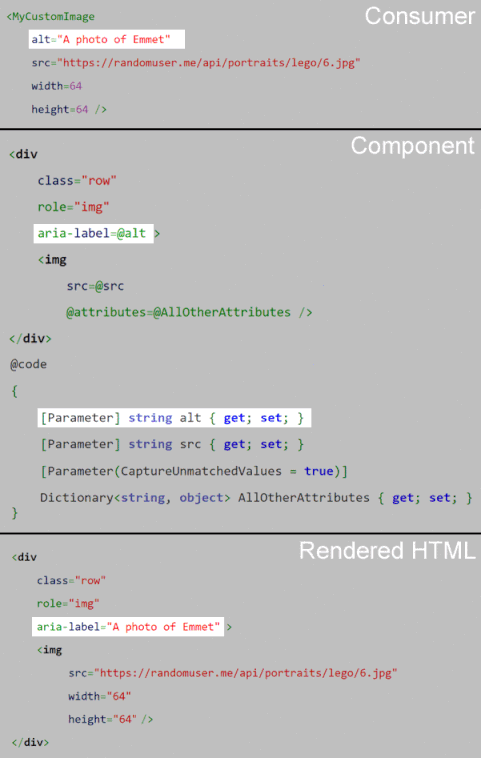Previously we've seen how to declare parameters and cascading parameters with specific names. Take, for example,
a custom component that wraps an <img> element inside some custom HTML.
<div class="row">
<img src=@src/>
</div>
@code
{
[Parameter]
public string src { get; set; }
}
During review it is pointed out that images without an alt tag are not very accessible to people with vision impairments,
so another parameter is added and the HTML updated.
<div class="row" role="img" aria-label=@alt>
<img src=@src/>
</div>
@code
{
[Parameter]
public string src { get; set; }
[Parameter]
public string alt { get; set; }
}
Over time more attributes are required:
- align
- width
- height
At this point you are likely to stop having additional requirements for an image component, but having to write a parameter
for every possible attribute every time you write a component can be tiresome,
especially when you don't actually process the values but simply pass them through to the HTML element's mark-up.
The <input> control has approximately 30 attributes that would require us to write parameter code for.
Capturing values without coding parameters
Previously we saw how to utilize Attribute splatting to programmatically
generate HTML attributes and their values.
This involved assigning the value of a Dictionary<string, object> to a specially named @attributes attribute.
Capturing values of attributes without matching parameters works in a similar way.
We simply create a property of type Dictionary<string, object>, decorate it as being a [Parameter],
but in the Parameter we need to specify CaptureUnmatchedValues = true.
<div class="row" role="img" aria-label=@alt>
<img src=@src @attributes=AllOtherAttributes />
</div>
@code
{
[Parameter]
public string src { get; set; }
[Parameter]
public string alt { get; set; }
[Parameter(CaptureUnmatchedValues = true)]
public Dictionary<string, object> AllOtherAttributes { get; set; }
}
Now instead of throwing an exception when the consumer of your component adds attribute values you have not explicitly
permitted with a [Parameter] decorated property (the normal behavior), Blazor will collect them into the dictionary
for us as Key/Value pairs.
In the preceding example, any attributes=value assignments specified by the consumer of our component will be added to
the <img> element within our component.
<MyCustomImage src="https://randomuser.me/api/portraits/lego/6.jpg" alt="A photo of Emmet" width=64 height=64 />


